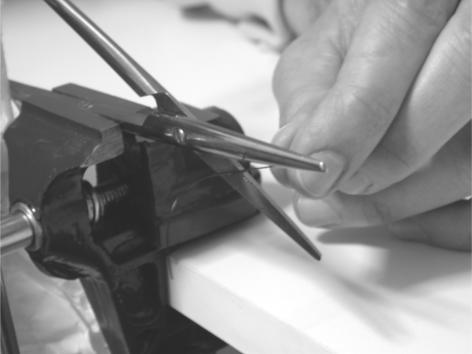BACKGROUND
Mayo scissors are amongst the most commonly used instruments in theatre. During their working lives they often become defective, causing substandard performance. Attempts to analyse their quality and efficacy are compromised as individuals asked to test scissors manually exert differing forces when closing the blades and use subtly different techniques, making comparison of data difficult. We describe an objective method by which these important tools can be assessed.
TECHNIQUE
The lower handle of the scissors was immobilised in a desk-top vice. A 190-g weight was tied to the free arm. Scissors were opened to an angle of 45° and suture material was placed where the blades intersect (Fig. 1). The weight was then released. If the suture material was not cut then the process was repeated. The greater the number of repetitions required to severe each suture completely, the less effective the scissors were. Where a suture was partially severed by the scissors, the damaged portion of the material was placed where the blades would strike it at the next application of the test process (Fig. 2). We tested scissors against a battery of commonly used suture materials and compared them to scores obtained by new scissors.
Figure 1.
The test rig.
Figure 2.
The re-test.
DISCUSSION
Defective theatre equipment may have a range of consequences from the seemingly trivial to the potentially life or limb threatening. Mayo scissors sustain a great deal of ‘wear and tear’ through continual, and sometimes inappropriate, use. An objective method of assessing their competence is important when managing their upkeep and considering their timely replacement.




